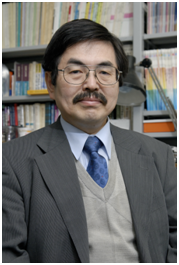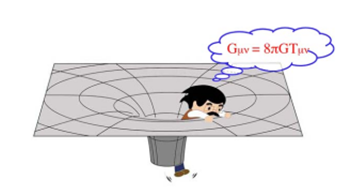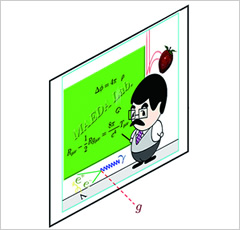
ページ読込中...

ページ読込中...

[English]
| 前田 恵一 [教授] |  |
|
| homepage | ||
| 専門分野 | 宇宙物理 | |
| 研究テーマ・研究活動 | ||
| ○素粒子統一理論を基礎にした宇宙論・ブラックホール ○非線形物理学としての宇宙の構造形成 ○一般相対性理論の基礎的問題と重力波 |
||
| ●日本物理学会 日本天文学会 国際天文連合(IAU) アメリカ物理学会 日本「一般相対性および重力」学会組織委員 「一般相対性および重力」国際学会編集委員 |
||
研究内容:相対性理論を基礎にした理論宇宙物理学。主に次の3つの研究分野からなる。
(1)素粒子的宇宙物理学:ビッグバンは非常に成功した理論であるが、それらは同時に宇宙のはじまりを予言する。その宇宙のはじまりがどのようであったのか、どのようにビッグバン宇宙へと進化していくのかなどを素粒子論や超ひも理論をもとに考察している。また、素粒子の統一理論に基づいた新しいタイプのブラックホール解を見つけ、研究することにより、重力現象のより深い理解をめざしている。
(2)宇宙の構造形成と非線型物理学:宇宙の温度が4000度ぐらいの時、宇宙は中性化され光が自由に行き来できるようになる。そのときに存在した密度のでこぼこが成長し、現在の銀河や銀河団といった宇宙の構造が形成されるのであるが、そのメカニズムはまだ解明されていない。本研究室ではこの構造形成問題をカオスやフラクタルなどの非線型物理学の立場から研究している。
(3)ブラックホール・中性子星と重力波:アインシュタインの一般相対論によって新しく予言されたものに、ブラックホールと重力波がある。ブラックホールは星の進化の最後に形成されたり、銀河の中心に存在することが観測から示唆されている。一方、重力波も連星パルサーPSR1913+16の観測から間接的にはその存在が証明されている。現在では、その重力波を直接観測し、ブラックホールや中性子星の性質や形成過程を解明しようという大規模観測プロジェクトが世界各地で進められており、理論的にもその現象の詳細な解析が求められている。そこで数値相対論などを駆使し、中性子星やブラックホール形成過程やそれに伴う重力波放出過程の理論的解析にも力を入れている。

学生に一言:知識の丸暗記するだけで問題を解いたり、考えたりすることのないように。自分でちゃんと内容を理解することが重要である。特に、教科書に書かれているからとか、先生が言ったからというだけで正しいと信じてしまうことのないように。
| Kei-ichi Maeda [Professor] |  |
|
| homepage | ||
| research field | Research on cosmology and black holes as fundamental physics | |
| research keywords | ||
| General relativity and gravitational physics The Early Universe in unified theory of fundamental interactions Black holes and relativistic astrophysics |
||
| link | ||
| Research Profiles (at Faculty of Science and Engineering)Research Profiles (Elsevier SciVal Experts) | ||
I mainly work on gravitational physics and cosmology based on unified theories of fundamental interactions. In 1986, when I was a postdoc at the Meudon Observatory, I worked with Professor Gary Gibbons (Cambridge), who at the time was a visiting professor there,and found black hole solutions in string theory. The paper written with Gary is now one of the most popular papers in this field. The citation number in the SPIRES database at SLAC is now 712. When I visit Cambridge now, I always go to Gary’s office for useful discussions. This helps my research significantly.
In 1999, a workshop was held at the Isaac Newton Institute on “Structure Formation in the Universe.” During my sabbatical, I attended this workshop for three months. I had interesting discussions with numerous prominent scientists, including people at Cambridge. I began work on “a brane cosmology” there.
In particle physics, all interactions could be unified in higher dimensions.
However, our universe should be three dimensional. To explain our universe in the context of higher-dimensional unified theories, we introduce the idea of a brane, a three dimensional object moving in higher-dimensional spacetime.
Taking this model, many researchers have studied the early stage of the Universe or strong gravitational phenomena such as a black hole.
During the workshop, I finished four papers, which became the most widely cited ones in this field (The citation numbers are 831, 215, 176, and 124). One of these written with Professors Tetsuya Shiromizu (TITech) and Misao Sasaki (Kyoto) derives an effective gravitational theory for our universe based on the Randall-Sundrum brane world scenario.
I have published 181 papers to date. The total number of citations is over 5000, and the h index is 36.
I also manage international research collaborations. For example, I am the PI of the Japan-U.K. Research Cooperative Program (2005-09). I am also a member of the International Committee on General Relativity and Gravitation (GRG) and editor of the Journal of GRG.
Current topics include research on “cosmology and black holes” as fundamental physics. Inflation, which is believed to occur in the early stage of the Universe, is also entering a new stage and can now be discussed based on unified theories such as superstring theory. I recently presented a new type of inflation in a string model with correction terms.
I am also working on black hole solutions in string theory. More recently, my interests have turned to so-called dark energy, one of the most important subjects in modern cosmology. My goal is to continue this research and to find interesting new aspects in cosmology or gravitational physics.
 Based on the unified theory of fundamental interactions, our universe may be a membrane (three-dimensional space) moving in higher-dimensional spacetime. Standard model particles such as quarks and leptons as well as gauge particles such as photons and gluons are confined to the three-dimensional brane (our world), but gravitons can propagate in the higher-dimensional bulk space. This world view may change the scenario of the evolution of the early universe. It is called a brane world.
Based on the unified theory of fundamental interactions, our universe may be a membrane (three-dimensional space) moving in higher-dimensional spacetime. Standard model particles such as quarks and leptons as well as gauge particles such as photons and gluons are confined to the three-dimensional brane (our world), but gravitons can propagate in the higher-dimensional bulk space. This world view may change the scenario of the evolution of the early universe. It is called a brane world.